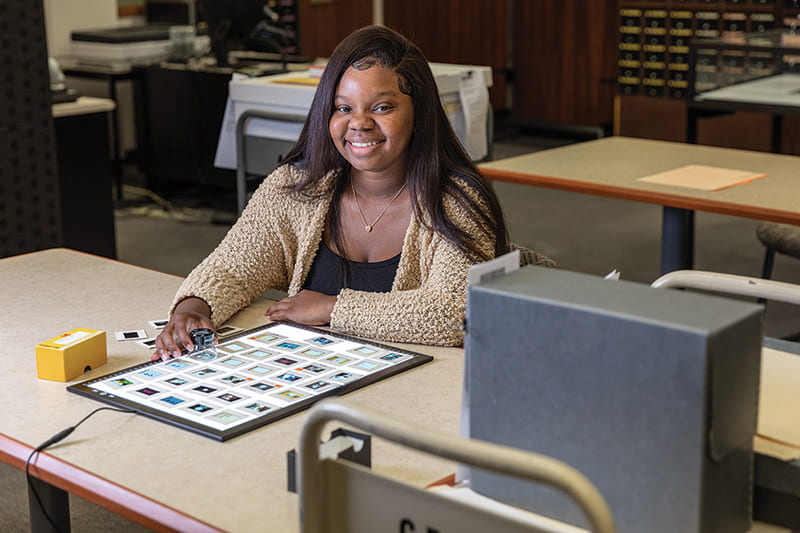
By Nastajae Alderson
Photos by Chieko Hara
Nastajae Alderson is an Honors College Path Scholar majoring in English education. An opportunity to interview and record the memories of her community’s elders sparked her interest in researching and sharing the stories of people of color. Join her for a walk through her hometown.
Just six miles from the Louisiana border in southern Arkansas there is a wooden sign that says, “Welcome to Huttig.’’ Huttig is home to roughly 450 people, one thriving lumber company, one convenience store, one small library, one post office and the story of my life.
Upon entering town, you’ll see the place where my story began, the Huttig School District: a basketball gym with doors no longer intact, two classroom buildings overgrown with weeds, and a faded painting of the United States on the concrete entry way. I attended school there until the second grade, when our district was forced to consolidate with a neighboring district due to low enrollment. During my short time at the school, there were two teachers that I looked up to who continue to inspire me to this day: Iris Lee-Barr and Brenda Daniels. I believe that they saw something in me at the time that I didn’t see in myself, because they constantly encouraged me to be my best self in everything I did inside and outside of the classroom. Even though it was heartbreaking to leave, they sparked my love for education and inspired me to pursue a career in the teaching profession.
Further down the road lies the heartbeat of the town, West Fraser Lumber Mill, which helped found Huttig in 1906. For most of my life, my mother and father have been exceptional employees at West Fraser. On the hottest summer days and coldest winter nights, they work in a sawmill operating machinery to turn logs into dimensional lumber. Watching my parents made me realize that this was not where I wanted to be. I want my hard work to take me further, and they consistently told me that there was more life to experience beyond the mill.
Choosing a college after graduating high school was difficult at first, simply because I was afraid to leave. I decided to attend the University of Arkansas, which was five and a half hours away from everything and everyone I knew. The jump from living in a town with fewer than 500 people to a university with classrooms holding 400+ students at one time was not an easy one to make. I also struggled with feeling like I was turning my back on my family and community by going so far away.

One of the most rewarding opportunities I have had at the University of Arkansas was my summer internship with Arkansas Folk and Traditional Arts, where I was able to come back to my hometown to interview members of my community and give them a voice. They talked about their history, their town and shared their stories.
Being from such a small town, it is easy to feel like you’re forgotten, and I wanted to show my community that I see and hear them.
These interviews brought a sense of joy to the community that I hadn’t seen before. I wanted to continue research on underrepresented people and give others a voice as well.
Last spring, I had the opportunity to intern with the University of Arkansas for Medical Sciences Historical Research Center assisting with a project on “Arkansas Women of Color in Medicine.” I conducted graduate-level research on topics such as tuberculosis, midwifery, Arkansas women’s rights, pediatrics and obstetrics. The saddest, hardest part of this work was discovering that women of color were at a disadvantage when it came to articles, newsletters, clippings and materials collected on them. There were some weeks that I would be stuck with just a photo of a woman of color, but she would be listed under her husband’s first and last names — cutting off the possibility of discovering more about her. Though they are not here to see their hard work being recognized,
I helped give a platform to Annie Loggin, Chinan A. Fan, Virginia Cully and many more for their stories to be heard.
Like these women whose stories were forgotten, Huttig also has impactful figures whose names are worth remembering. As we continue our walk, we move across the abandoned car wash lot, the pond and the church lawn and pass the homes of Lenora Roach, Jefferson Davis-Holley and Joyce Mitchell — a few of our oldest living residents and culture bearers of the town. Past residents of Huttig didn’t have the opportunity for their lives and experiences to be documented and remembered after their passing, but these residents will have that chance. Their interviews will be archived in the Arkansas Folk and Traditional Arts collection and the Special Collections Department in the University of Arkansas Libraries, which has open access to the public.
Finally, in sight is Daisy L. Gatson Bates Street, where I have lived most of my life, named in memory of the civil rights activist who was born in Huttig. The concept of “home” is one that I found myself struggling with when I moved away for college. I had to juggle two lives, two identities and two homes. As I grew older, I realized that it’s not a matter of choosing one over the other, but a merging of the two. Here on this street is my childhood home, my siblings, my family, my motivation. My home here led me to my home in Fayetteville, which will eventually lead me on a much greater path to a new home one day. No matter where life takes me after college, Huttig will always be my first home.
Alderson’s work with Arkansas Folk and Traditional Arts was supported by an Honors College Domestic Internship Grant.




